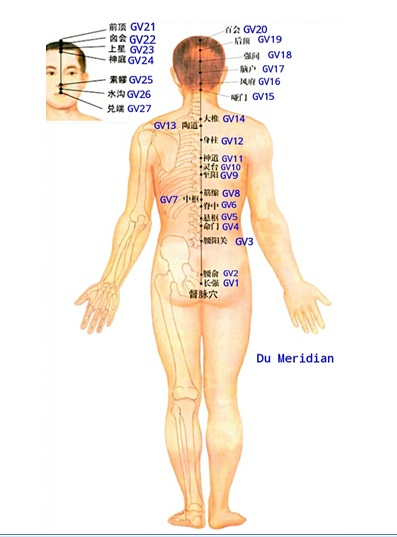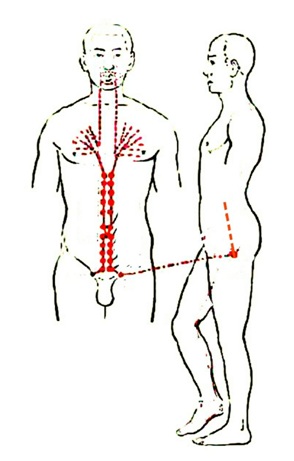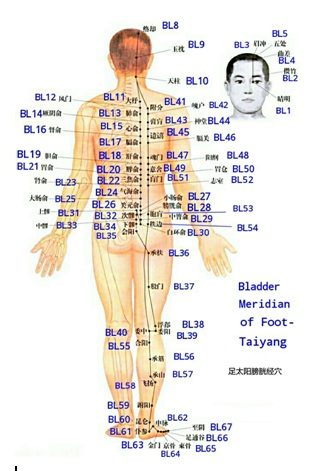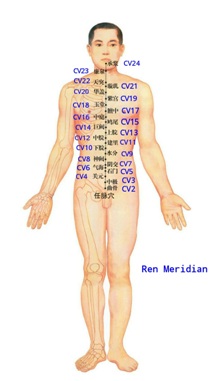
Opening up a New Field of Modern Medical Research 2
*Corresponding Author(s):
Li XiaoguangTraditional Chinese Medicine In Shaanxi Province, China
Email:lxg090@qq.com
Abstract
Modern medicine tells us that the human body is an organism composed of heart, lung, liver, kidney, spleen, stomach, brain, nerves, muscles, bones, blood vessels, blood and so on, while Traditional Chinese Medicine believes that besides these tissues and organs, the human body still has another part of the structure, Traditional Chinese Medicine calls them Jing Luo and Shu Xue. Jing Luo means the longitudinal line of the human body and the accompanying net, translated into English Meridians and Collaterals. Shu Xue means holes distributed on Jing Luo and outside Jing Luo, because stimulating Shu Xue's position by acupuncture, massage and other methods can cure diseases, so Shu Xue is translated into English acupuncture point, abbreviated as acupoint or point. Meridians and acupoints are the special knowledge of the human body structure in Traditional Chinese Medicine. Traditional Chinese Medicine not only draws the distribution map of the meridians and acupoints in the human body, but also has been using them to treat diseases for thousands of years. There are hundreds of these acupoints, stimulating each one by acupuncture, massage or other methods will have a special effect on the human body and can treat various diseases. But what effect does stimulating every acupoint have on the human body so that it can treat various diseases? The discussion of Traditional Chinese Medicine is vague and incomprehensible, and can not be proved by experiments.
According to the author's research for more than 30 years, this paper makes a clear and accurate exposition of the effects on the human body and diseases that can be treated with acupoint massage. These statements can be proved by experiments, so they are believed to be reliable. It is hoped that meridians, acupoints and massage therapy can be incorporated into modern medicine and become a part of modern medicine after being proved by others through experiments.
Massaging acupoints can not only treat many diseases that are difficult to be treated with drugs, but also have simple methods and low cost.
Keywords
Acupoint; Blood; Ligament; Massage; Meridian; Physiology; Traditional Chinese Medicine
INTRODUCTION
Medicine is not only a science to study the structure and laws of the human body, but also a technology to treat and prevent diseases. In ancient times, different regions used to have different medicine, they had different understanding of the human body and adopted different treatment methods for diseases. However, in modern times, European medicine has achieved rapid development with the help of modern scientific and technological progress, and has soon been accepted by all countries in the world to become world medicine and gradually developed into modern medicine. At present, the research and understanding of the human body in modern medicine has been very thorough and meticulous, reaching the molecular level. Since modern medicine has such a thorough and detailed understanding of the human body, in theory, most diseases of the human body should be cured, but the actual situation is not the case. There are still a large number of diseases that modern medicine is powerless and difficult to cure, even a considerable number of which are seemingly uncomplicated diseases. So what is the reason? The reason is that the current modern medicine has defects and deficiencies in understanding the laws of human body. Meridians and acupoints are very important parts. According to thousands of years' experience of Traditional Chinese Medicine and the author's research, a large number of diseases in the human body are related to meridians and acupoints, which can be treated through meridians and acupoints. Unfortunately, modern medicine knows nothing about this.It is hoped that more people can devote themselves to the research of meridians and acupoints.. This will be a promising field.
The Effect on the Human Body and Diseases that can be Treated of Massaging the Acupoints on Du Meridian, Chong Meridian, Ren Meridian and Bladder Meridian
Stimulating acupoints with acupuncture, massage, electricity, cold, heat and other methods will have effects on the human body. The author used massage in his research. The method of massaging acupoints can be either pressing the acupoints with fingers or other things, or rubbing the acupoints with fingers. The interesting thing is that even if you press your finger on the acupoint, no pressure, no friction, will also have the same effect, even through thin clothes can be. Dozens of times or tens of seconds can be used every time. The ones who are physically strong and have certainty about the nature of the disease and the choice of acupoints can be more, while those who are young, old, weak or uncertain about the nature of the disease and the choice of acupoints can be less. It starts to work after the massage, the effect will continue for 7 hours and 40 minutes, and then stop. If you fall asleep in the middle, the period of sleep will not be included in the 7 hours and 40 minutes, because the effect will stop temporarily after you fall asleep and resume after you wake up. For example, when you massage acupoints at 7 o'clock in the evening and fall asleep at 10 o'clock, the effect will stop. When you wake up at 6 o'clock in the morning, the effect will resume again, and then continue until 10:40. The effect of stimulating acupoints is not always manifested very well every time due to various factors, for example, for some reason, stimulating acupoints with opposite effects at the same time can offset the effect, because there are many acupoints in the human body that are stimulated to produce opposite effects.
The Meridian Drawn In The Following Picture Is The So-called Du Meridian In Traditional Chinese Medicine (Figure 1)
 Figure 1: Du Meridian.
Figure 1: Du Meridian.
There are about ten acupoints above Mingmen acupointGV4 on Du Meridian, which are associated with heart, lung, spleen, stomach, liver, kidney, large intestine, small intestine, gallbladder and bladder respectively and control the blood flowing into heart, lung, spleen, stomach, liver, kidney, large intestine, small intestine, gallbladder and bladderrespectively. A healthy body requires that the blood flowing into the above-mentioned organs is appropriate, so that the function of each organ can be normal, otherwise too little blood flows into the above-mentioned organs, it will lead to the decline of the function of the above-mentioned organs, the reduction of heat production and chills, which is what Traditional Chinese Medicine calls yang deficiency, such as heart yang deficiency, lung yang deficiency and so on. On the contrary, if too much blood flows into the above-mentioned organs, it will lead to hyper-function of these organs, fever, inflammation, pain, diarrhea, bleeding, and so on. Different organs will have different manifestations. Which is what Traditional Chinese Medicine calls Yang excess, for example, heart Yang excess, Lung Yang excess and so on? Massage, pat and stimulation of these acupoints will increase the blood flow into the corresponding organs, which can respectively treat the diseases caused by insufficient blood supply to various organs, that is, yang deficiency. But it is not suitable for the opposite situation, that is, yang excess, which should be banned. As for how to reduce the blood flowing into various organs and treat diseases caused by excessive blood flowing into various organs, that is, yang excess, please see the author's paper "Opening up a New Field of Modern Medical Research 1" published in the preprint of osf. However which acupoint corresponds to which internal organs, it still needs to be studied in more detail.
The Meridian Drawn In The Following Picture Is The So-called Chong Meridian In Traditional Chinese Medicine (Figure 2)
 Figure 2: Chong Meridian.
Figure 2: Chong Meridian.
There are about ten acupoints on the section of Chong meridian which is located on the surface of chest and abdomen, which are connected with heart, lung, spleen, stomach, liver, kidney, large intestine, small intestine, gallbladder and bladder respectively, and control the blood flowing from heart, lung, spleen, stomach, liver, kidney, large intestine, small intestine, gallbladder and bladderto veinsrespectively. A healthy body requires that the blood flowing from the above-mentioned organs to veins is appropriate, so that the functions of the above-mentioned organs can be normal. Otherwise, if too much blood flows from each organ to vein, it will lead to insufficient blood, decreased function, decreased heat production and chills in each organ, which is called Yin excess in Traditional Chinese Medicine. On the other hand, if there is too little blood flowing out of each organ, it will cause the blood circulation of each organ to be blocked and each organ to be congested, which is what Traditional Chinese Medicine calls Yin deficiency. Massaging, beating and stimulating these acupoints can increase the blood flowing out from each organ, and can treat diseases caused by too little blood flowing out from each organ, that is, Yin deficiency. But it is not suitable for the opposite situation and should be prohibited. As for how to reduce the blood flowing into veins from various organs and treat diseases caused by excessive blood flowing Out form various organs, that is, Yin excess, by massage, please see "Opening up a New Field of Modern Medical Research 1". However which acupoint corresponds to which internal organs, it still needs to be studied in more detail.
The Meridian Drawn In The Following Picture Is The So-called Bladder Meridian Of Foot-Taiyang And Ren Meridian In Traditional Chinese Medicine (Figures 3 & 4)

Figure 3: Bladder Meridian of Foot-Taiyang.

Figure 4: Ren Meridian.
The acupoints on the branch of the Bladder Meridian of Foot-Taiyang located on the waist and back near the Du Meridian, such as BL13, BL15,BL18, BL23, etc. and the acupoints on the section of Ren Meridian located on the chest and abdomen ( except shenque acupoint CV8 ) are associated with heart, lung, spleen, stomach, liver, kidney, large intestine, small intestine, gallbladder and bladder respectively, and respectively control the tension of ligaments used to fix the positions of various visceral organs. A healthy body requires that the tension of the ligament of each visceral organ is appropriate, so the body will be normal, on the other hand, if the tension of the ligament of each visceral organ is too large or too small, people will feel uncomfortable, and the body will be abnormal, while in sufficient tension of the ligament is the cause of the sagging of the visceral organs. Stimulating these acupoints by massaging and beating will increase the tension of the ligament of each visceral organ. As for how to reduce the tension of ligaments in each internal organ, please see “Opening up a New Field of Modern Medical Research 1” [1,2].
REFERENCES
- Yanchi L (1987) Basic Theory of Traditional Chinese Medicine, Jiangxi Science and Technology Press, China.
- Xin L, Wei Y (2006) The theory of meridians and Acupoints. Science and Technology Literature Publishing House, China.
Citation: Xiaoguang L (2020) Opening up a New Field of Modern Medical Research 2. J Altern Complement Integr Med 6: 121.
Copyright: © 2020 Li Xiaoguang, et al. This is an open-access article distributed under the terms of the Creative Commons Attribution License, which permits unrestricted use, distribution, and reproduction in any medium, provided the original author and source are credited.

